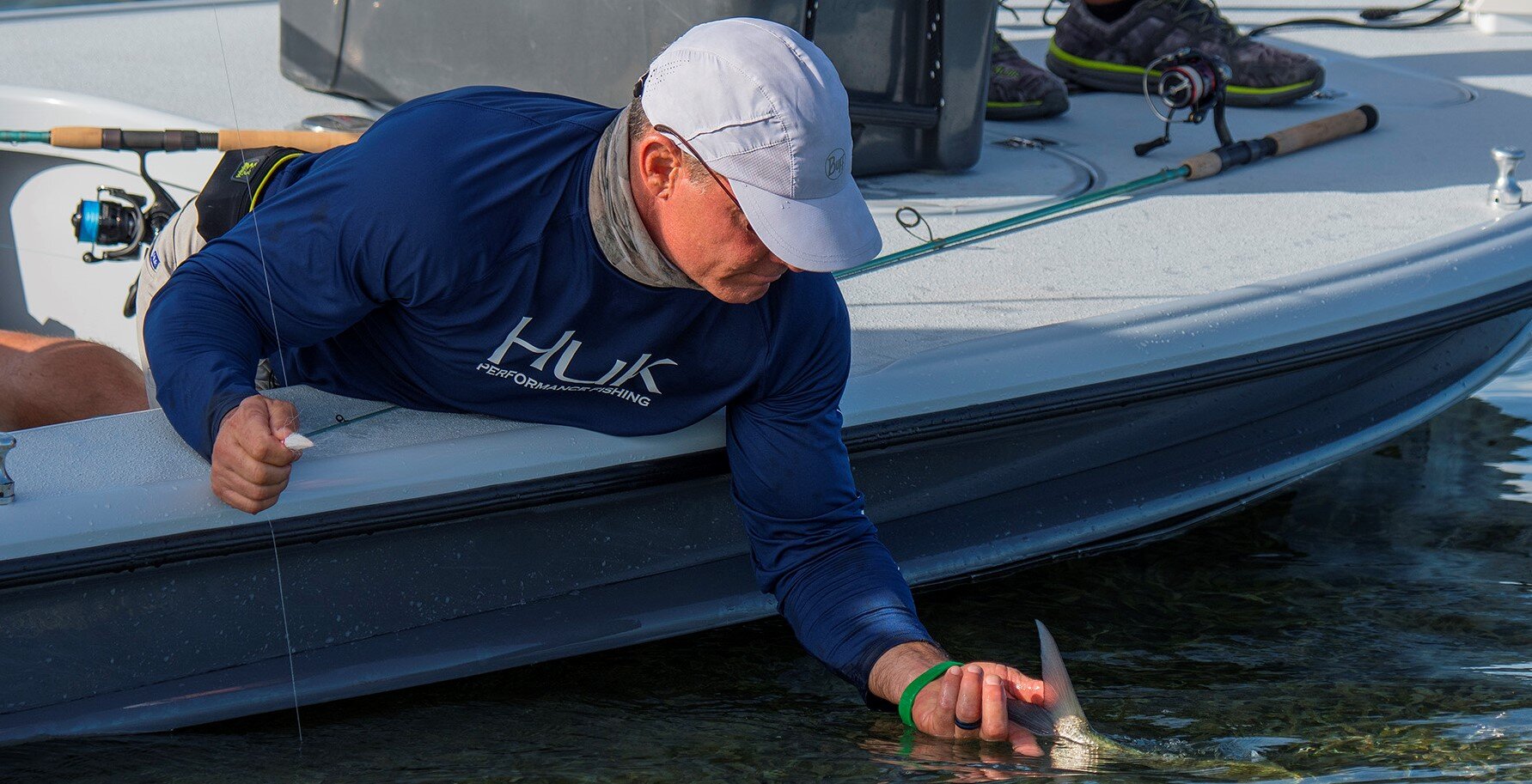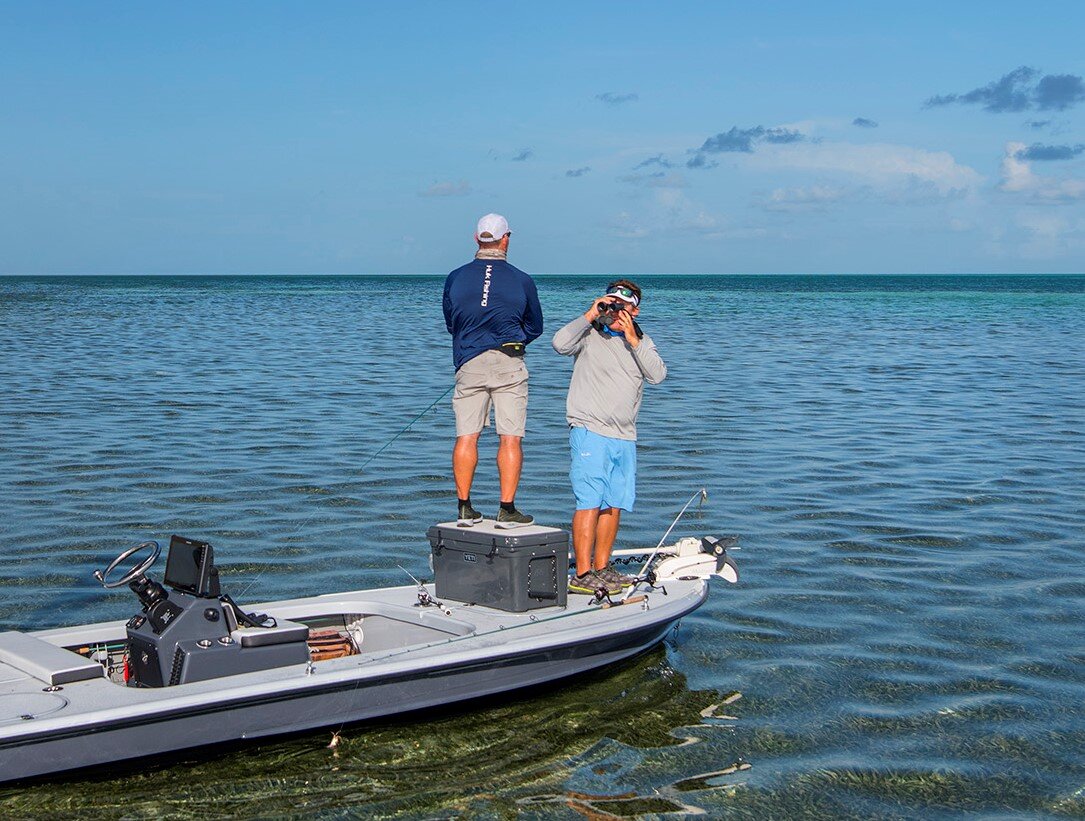How to Catch a Key West Grand Slam
performance fishing
find all your huk gear today
written by Evan Anderson
In this episode of Saltwater Experience, Captains Tom Rowland and Rich Tudor join up with Nick Labadie, an accomplished guide in Key West, Florida. It happens to be Rowland’s birthday, so, to celebrate, the trio sets out to try for a Grand Slam, an impressive accomplishment in which an angler catches a tarpon, a bonefish, and a permit in one day. “To be able to get a Key West grand slam is something in itself,” says Labadie, “It’s a very challenging fishery and you really have to not only be able to understand and control the equipment and the spinning rod, make a great cast with a 15 mph wind, but also understand the fish and how it’s going to react to what you’re presenting to it.”
It’s a race against time leading to an incredible day on the water and a memorable birthday for Rowland. We’ll take a look at some of the techniques they employed to catch each species so that you can go out and get your own Key West Grand Slam.
@ SE Multimedia 2020
TARPON
It’s about 6:30 am, just as the sun is beginning to peek over the horizon, and Capt. Labadie is charging ahead to the crew’s first destination. Since tarpon are the easiest of the three to catch in low light conditions, this is where Labadie opts to start. Rowland and Tudor remark that they were somewhat surprised at first by the guide’s choice to fish right in front of the coastline resorts and houses. On a day that they were purely targeting tarpon, the Saltwater Experience hosts would tend to go somewhere a little more remote. Labadie chose this spot because he knew the fish would be there, but, more importantly, it was on the way to their other targets, eliminating the need to backtrack later and burn up precious time.
@ SE Multimedia 2020
Tudor opted for a live pinfish under a cork while Rowland decided to use jerk baits. “Just looking at what those fish were doing, there was zero doubt in my mind that they were gonna eat the jerk bait,” says Rowland. According to Rowland, it’s ideal if the fish are relaxed. You can tell by the way they roll along the surface, something they do to gulp air and fill their “swim bladder”, essentially a specialized lung that allows them to live in poorly oxygenated water. If this roll appears slow and easy, it means that the fish is relaxed and will bite really well, according to Rowland. Having seen this behavior that morning, Rowland opted for jerk baits because they allowed him to cast twice as far and more frequently. This way he can cast way out past the fish and reel back toward them so as not to spook them with the splash of his lure.
“Just looking at what those fish were doing, there was zero doubt in my mind that they were gonna eat the jerk bait”
Within seconds of his jerk bait hitting the water, a good-sized tarpon slams on his hook. “Then the trick with tarpon,” elaborates Rowland, “as it always is with tarpon, is, ‘are they gonna stay on?’” Tarpon have a very hard and rough mouth. Often even a very sharp hook will be thrown by the fish during the fight or the sandpaper-like edge will wear through a light leader. But the fish stayed on, miraculously. Grand Slam Step 1: Check.
BONEFISH
Once the tarpon are caught, Labadie’s attention turns to permit. He’s aware of the clouds rolling in and decides to leave the tarpon still biting hard to start heading that direction. In the summertime, this is a daily occurrence, clouds rolling in like this, making the race for the Grand Slam a lot more interesting. Rowland says that, when chasing a Grand Slam, you have to be intentional. Sometimes you have to leave a really good fishing hole to get after it.
Upon just a few minutes at the new flat, a splash catches their eye. Rowland, looking through his Nikon Monarch binoculars, says, “Those are bonefish. And they’re tailing really good.”
Bonefish are a favorite of the Saltwater Experience crew. And though they have years of experience going after this fish, they default to Labadie’s judgement as their guide. “Nick had us set up with a jig for the bonefish,” says Rowland, “Millions of bonefish have been caught on jigs, but I’m thinking, ‘if we’re going bonefishing for tailers, probably live shrimp or something, maybe fly fish for them.’” Tudor adds, “These were the heavier jigs, I guess ¼ oz. He liked these because they’re bigger, you can cast them further, cast them into the wind.” Labadie will tie his own jigs but these were commercially available models which Nick customized a bit by trimming them down a little shorter.
“He liked these [1/4 oz. jigs] because they’re bigger, you can cast them further, cast them into the wind.”
Sure enough, once their jigs are in the water, both Rowland and Tudor are hooked up with good-sized bonefish. With the binoculars, both Tom and Rich scan the flat for more tailers and find a slightly larger school. Labadie repeats his quiet approach and they land a few more hungry bonefish. With the sky fairly clear but lots of clouds on the horizon, Labadie knows they better leave these bonefish still biting like they did the tarpon and move on to find the last leg of the Slam, the permit. They are racing against time and clouds so that they can fish for the permit while the sky is clear and the sun is directly overhead offering the very best visibility. Seeing the fish is absolutely crucial to the success of any permit fisherman and all three of these guys know it. While the bone fishing was fun, it’s time to move on.
PERMIT
“One of the fish that I enjoy fishing for the most is the permit,” says Rowland, “The permit tends to be incredibly spooky when it’s calm, and the 15 to 20 mph winds with clear skies is definitely, in my opinion, the best conditions to fish for them.” Thankfully the summer weather provides the perfect conditions for permit fishing, and our hosts were glad to be wearing some good Huk shirts to keep the sun and wind off their skin. Labadie hurries them to a place he knows they can find permit, constantly aware of clouds on the horizon. “[Nick] knew we needed as much time as we could for the permit because the clouds were moving in and they’re really hard to find without good sun,” says Tudor. The ideal time period for permit and bonefishing is between 10 am and 2 pm. Before and after this window the angle of the sun creates too much glare to see the fish, a necessity for going after permit. Labadie maneuvers them into position and the search begins. With the sky still clear, Labadie sees what he came for, and now it’s a matter of landing a live crab right in front of the permit’s nose.
“The permit tends to be incredibly spooky when it’s calm, and the 15 to 20 mph winds with clear skies is definitely, in my opinion, the best conditions to fish for them.”
Live crab and live shrimp are the two baits of choice for permit. According to Rowland, shrimp are a fine bait, but die very easily after only one or two casts. Crabs last much longer, able to survive several casts, and don’t get eaten by smaller fish like snappers, whereas shrimp are easily swept up. Nothing else eats the crab in these spots besides the permit.
Rowland spots one and fires his crab right out in front of it. The fish blows out at first, but Rowland patiently waits while watching the fish. The permit turns and returns to look for the crab. With the boat held stationary, all three wait for something to happen. Rowland lets his live crab flee to the bottom and watches the permit tail up on it and do the signature wiggle that they do when they eat. He reels down and sets the hook.
Cheers of victory resound from the boat as he begins fighting to bring in his catch. “There are so many things that can go wrong,” reflects Rowland, “my first thought was that we needed to be as close as possible to this fish because he was heading into a deep channel that I know is full of sharks” Labadie knew this too and quickly got the Mercury motor started and idled toward the fish. They maneuvered around crab trap buoys and kept the sharks away until Tudor could get the fish in the Frabill net.
It’s truly an impressive fish. Once the fight is done, Rowland holds the permit up, admiring its beauty. The animal’s light scales, contrasted against Rowland’s dark Huk shirt, shine in the sunlight. A perfect way to end his grand slam and the perfect birthday present.
HAVING THE RIGHT GUIDE
Having the right guide will give you your best chance at success if you’re chasing a Grand Slam. Rowland expressed much gratitude for Nick’s guiding capabilities throughout the episode. “He had done such a good job of putting us on the fish,” says Rowland, “but not just putting us on the fish. He called his shots all day long. He put a lot of thought into his guiding, he was very prepared, and on top of that, Nick was a real fun guy to spend the day with.” If you’re planning on hiring a guide for your grand slam, make sure to do your research beforehand to find the right one.
@ SE Multimedia 2020
If you are interested in fishing with Nick Labadie, check out his website at tailingwaterexpeditions.com. You can also contact him via phone at 941-468-6975 or on Instagram: @captnicklabadie. To hear Nick’s story, listen to his full length episode on the Tom Rowland Podcast. To hear more of his advice on permit fishing, check out this episode, also from the Tom Rowland Podcast.
“It’s an accomplishment for both the guide and the angler to be able to catch a tarpon, a bonefish, and a permit all in the course of a day.” says Rowland, “I’ve gotten a lot of slams, but that one was particularly rewarding because we were fishing with Nick for the first time ever.” Smiling, the trio heads back to shore, proud of each other for their accomplishment.
Ready to get your own grand slam? Check out the full episode below and see this miracle in action on S15:E2 of Saltwater Experience.


















